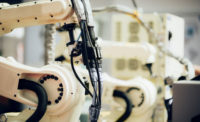OSHA in the age of robotics
Evolving tech may bring changes to 30-year-old LOTO rule

OSHA’s recent call for comments that may be used to help update its Lockout/Tagout (LOTO) standard highlights an area of growing concern for safety professionals: robotics-human interaction.
When the agency’s Control of Hazardous Energy (LOTO) standard was issued in 1989, industrial robots were in use – primarily in manufacturing – but they bore little resemblance to their modern day counterparts. In the 1960s, '70s and '80s, industrial robots were capable of gripping objects, moving them from one point to another and performing assembly tasks. industrial robots were capable of gripping objects, moving them from one point to another and performing assembly tasks. They were brightly colored and usually surrounded by fences or encased in cages – factors that enhanced the safety of the humans who worked in the same facilities.
The rise of cobots
Today, many of the devices are designed to work specifically alongside humans. These collaborative robots – cobots - are dexterous and flexible and can perform a wide range of tasks, including welding, painting, product inspection, die casting, drilling, glass making and grinding. They are used extensively in the aerospace, automotive, consumer goods, electronics, metals, food and beverage, foundry, medical, military, pharmaceutical, plastics, and wood industries. Robots are uniquely designed to perform hazardous and repetitive tasks and function in harsh environments.1
The current LOTO standard, published in 1989, requires that all sources of energy be controlled during servicing and maintenance of machines and equipment using an energy-isolating device. The standard specifies that control circuit devices cannot be used as energy-isolating devices, but the agency said it recognizes recent technological advances may have improved the safety of control circuit-type devices.
Among the information that OSHA is requesting from employers with regard to its LOTO standard is that which would help identify new risks of worker exposure to hazardous energy as a result of increased interaction with robots - and whether the agency should consider changes to the LOTO standard that would address these new risks.
Why it's hard to pin down the incident numbers
Many industrial robots do include safety features that reduce the risk of injury to workers, such as integrated sensors and devices that can detect a collision and effect a security stop. Nonetheless, injuries and fatalities caused by robot-human interactions have occurred, although quantifying the incidents is challenging due to a lack of standard classification codes.
Despite this limitation, National Institute for Occupational Safety and Health (NIOSH) researchers identified 61 robot-related deaths between 1992 and 2015 using keyword searches of the Bureau of Labor Statistics (BLS) Census of Fatal Occupational Injuries (CFOI) research database.2
NIOSH predicts that robotics-related fatalities will increase over time because of the increasing number of conventional industrial robots being used by companies in the United States, and from the introduction of collaborative and co-existing robots, powered exoskeletons, and autonomous vehicles into the work environment.3
Robotics safety research
In order to address the safety of today’s workers who use, wear, or work near robots, NIOSH established the Center for Occupational Robotics Research in September 2017. To address robot-related injury and death, CORR works in partnership with academic researchers, trade associations, robotics manufacturers, employers using robotics technology, labor organizations, and other federal agencies to:
- monitor trends in injuries associated with robotics technologies
- evaluate robotics technologies as sources of, and interventions for, workplace injuries and illnesses
- establish risk profiles of robotic workplaces and
- develop and communicate best practices, guidance and training for safe interactions between human workers and robots/robotics technology.
There are currently no specific OSHA standards for the robotics industry.
The American National Standards Institute (ANSI) and Robotics Industries Association (RIA) have issued standards for industrial robots that provide robotic definitions, engineering guidelines, evaluation criteria, testing requirements, and safety requirements. Click here for more information.
To comment on OSHA’s LOTO standard: Submit comments and materials electronically at http://www.regulations.gov on or before August 18, 2019.
1. https://www.robots.com/articles/the-many-capabilities-of-an-industrial-robot
2. https://www.cdc.gov/niosh/topics/robotics/aboutthecenter.html
3. Unpublished analyses by NIOSH Division of Safety Research. Though a Memorandum of Understanding with BLS, NIOSH receives CFOI research files with restricted access requirements. Research for this document was conducted by NIOSH using these restricted access files. The views expressed herein do not necessarily reflect the views of BLS.
Looking for a reprint of this article?
From high-res PDFs to custom plaques, order your copy today!









.jpg?t=1721257160)